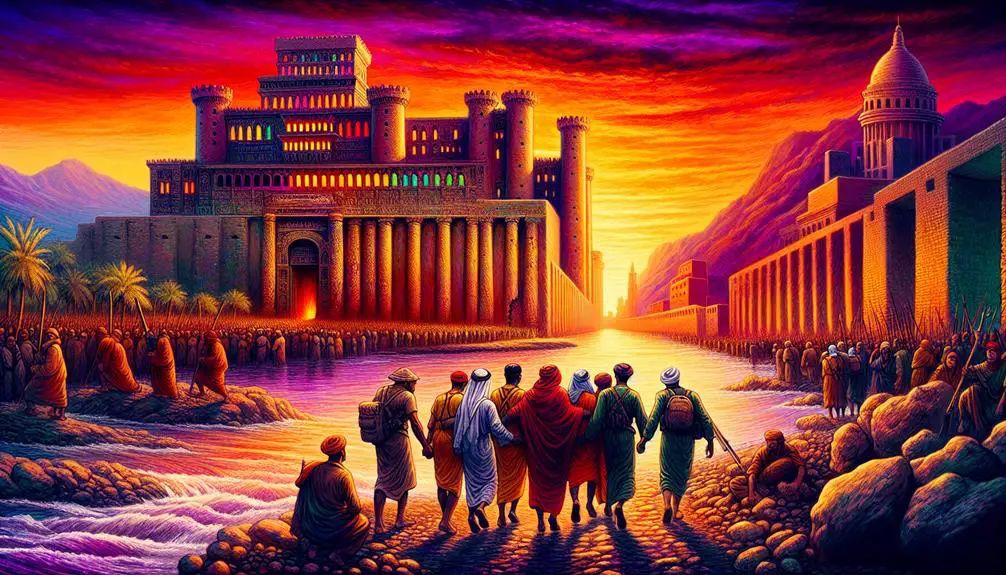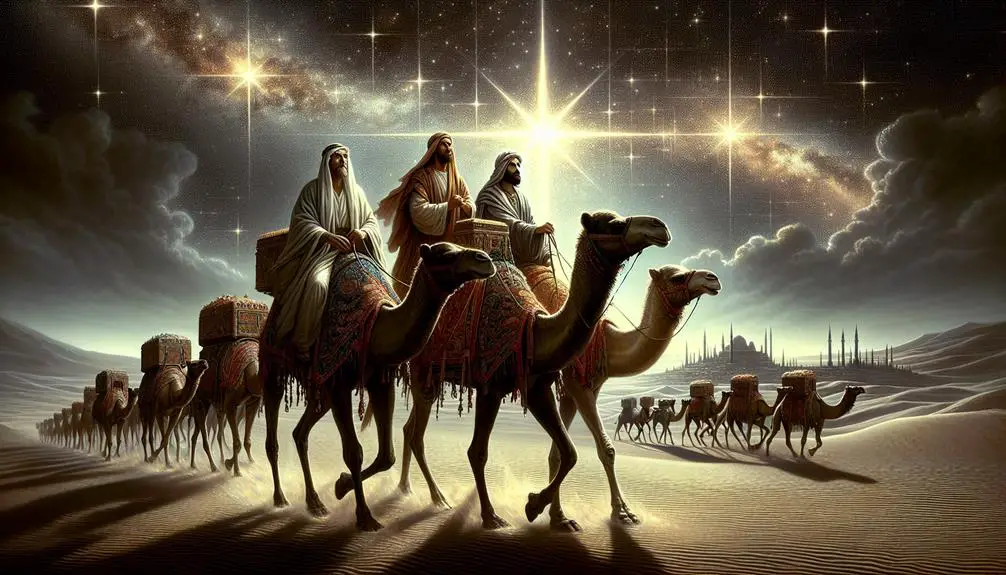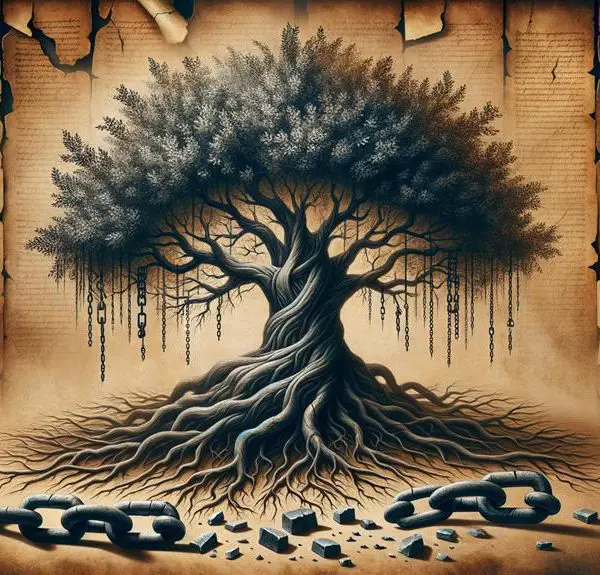Gain insight into how the East in the Bible symbolizes more than just a direction, revealing deep mysteries and divine encounters.

East in the Bible
Imagine you're tracing the footsteps of the Wise Men from the East, a journey shrouded in mystery and rich in symbolism.
You've likely heard their story, how they followed a star to find a newborn king. This tale, while enchanting, is just one of many instances where the East holds a significant place within the biblical narrative.
From the lush Garden of Eden to the exiles in Babylon, the direction of East is not merely a compass point but a laden symbol of beginnings, exiles, and divine encounters.
Let's explore why this cardinal direction resonates so deeply within these ancient texts, inviting you to uncover layers of meaning that might have eluded you before.
Key Takeaways
- The East symbolizes beginnings, renewal, and the divine presence, often staging pivotal biblical events and revelations.
- Visionaries and narratives in the Bible frequently orient towards the East to signify life, hope, and direct divine intervention.
- Morning rituals and prayer orientations towards the East embody spiritual awakening, enlightenment, and a connection with the divine.
- The journey of the Wise Men, guided by a star in the East, represents fulfillment of prophecy and divine guidance in Christian tradition.
The Garden of Eden

In biblical narratives, the Garden of Eden emerges as a seminal locale, symbolizing the initial human abode and the subsequent fall from grace. This setting isn't merely geographical; it's deeply allegorical, representing a state of innocence and unblemished communion with the divine. You'll find that the story of Eden is foundational, introducing the concept of original sin through the serpent's deception.
The serpent, a cunning creature, exploits the naivety of Eve, leading to the consumption of the forbidden fruit. This act isn't just a breach of divine command; it's the genesis of human moral consciousness and the inevitable estrangement from Edenic perfection. The serpent's deception marks the inception of original sin, a theme that resonates through theological discourse. This sin isn't merely an act but a condition, inherited and perpetuated through generations, signifying the inherent imperfection and the perpetual human struggle towards redemption.
Analyzing the Eden narrative, you're prompted to contemplate the complexities of free will, temptation, and the consequences of disobedience. It's a tale that serves as a poignant reminder of the frailty and fallibility inherent in human nature, setting the stage for the overarching biblical message of salvation and grace.
Journey to the Promised Land

Transitioning from the narrative of original sin and the loss of Eden, the biblical text unfolds the journey to the Promised Land as a pivotal phase in the formation of a covenant community, reflecting a profound quest for redemption and divine fulfillment. This trek, under Moses' leadership, isn't merely a physical relocation but symbolizes a spiritual passage from bondage to liberation, from estrangement to reconciliation with the divine.
Moses' role is critical; he's not only a leader but a mediator between God and the Israelites. His leadership is tested through various trials, from the parting of the Red Sea to the provision of manna from heaven. These episodes underscore a dependence on divine intervention and guidance throughout their journey.
The Canaanite conflicts, moreover, aren't just military encounters but are laden with theological significance. They represent the clash between the covenant community's faithfulness to Yahweh and the seductive pull of Canaanite religious practices. These conflicts test the Israelites' commitment to the covenant, highlighting the struggle between divine fidelity and cultural assimilation.
In essence, the journey to the Promised Land is a narrative rich in themes of leadership, faith, and the complexities of maintaining a covenant relationship with the divine amidst external temptations and trials.
The Tower of Babel

Shifting our focus to the Tower of Babel, we encounter a narrative that underscores humanity's ambition and the complexities of divine-human interaction. This story, steeped in the annals of biblical history, illustrates the pivotal moment of language confusion and the thwarting of architectural ambition.
You'll find that the Tower of Babel isn't merely about the construction of a tall building; it's a profound exploration of human pride and the desire for unity turned into division. This narrative highlights how the collective aim to reach the heavens, symbolizing a peak of human achievement, is met with a divine response that redefines human existence.
Here's a brief overview to deepen your understanding:
Aspect |
Detail |
|---|---|
Location |
Plains of Shinar |
Objective |
Construct a tower to reach the heavens |
Outcome |
Divine intervention causing language confusion |
This event marks a significant shift in the biblical narrative, emphasizing that human endeavors, no matter how grand, are subject to divine will. The resulting dispersion and diversity of languages serve as a reminder of the limitations imposed on human ambition and the profound impact of divine action on human history. Through the Tower of Babel, we grasp the intricacies of language as both a unifying and dividing force, shaped by divine intervention in response to human architectural ambition.
The Exile to Babylon

You'll find that the Exile to Babylon significantly shaped Israelite society and theology.
The Babylonian Captivity's impact on Jewish identity can't be overstated, as it fostered a profound transformation in religious practices and community structure.
Upon their return from exile, the changes implemented set the foundation for modern Judaism, illustrating a pivotal moment in biblical history.
Babylonian Captivity Impact
The Babylonian Captivity, often referred to as the Exile, profoundly reshaped Jewish identity, theology, and communal life. The impact was multifaceted, touching upon:
- Cultural assimilation: Exposed to Babylonian society, you faced significant pressures to assimilate, blending your religious and cultural practices with those of your captors.
- Economic impact: The shift from a primarily agrarian society to living under Babylonian rule altered your economic structures and personal livelihoods, challenging traditional ways of life.
- Theological development: You started to rethink and reinterpret theological concepts, leading to a deeper, more introspective faith.
- Community cohesion: Despite the challenges, the experience fostered a stronger sense of community among you, uniting you through shared adversity and the collective yearning for home.
The Exile wasn't just a period of hardship; it was a crucible for transformation.
Return From Exile
Following the Babylonian Exile, your return to Jerusalem marked a pivotal moment in Jewish history, characterized by a complex process of rebuilding both the physical city and the communal identity. Cyrus's decree, a groundbreaking edict from the Persian king, catalyzed this return, allowing exiles to reclaim their homeland and restore the Temple, symbolizing a divine endorsement of your resettlement and religious revival.
Nehemiah's mission, intricately linked to this period of reconstruction, focused on fortifying Jerusalem's defenses. His leadership not only secured the city's physical safety but also revitalized communal morale and adherence to the covenant.
This era, thus, wasn't merely about the reconstruction of tangible structures but the reinvigoration of a collective identity, deeply rooted in faith and communal solidarity.
The Wise Men From the East

Exploring the narrative of the Wise Men from the East unveils a multifaceted dimension of biblical historiography, emphasizing their pivotal role in Christian tradition. You'll find that their journey, marked by profound faith and determination, isn't just a tale of travel but a rich symbol of divine guidance and revelation. Their story, deeply embedded in the Gospel of Matthew, invites you to consider the significance of their gifts and the celestial phenomena they interpreted as a herald of the Messiah's birth.
Here's what sets their narrative apart:
- Magi's Gifts: The gifts of gold, frankincense, and myrrh they presented to Jesus aren't merely tokens of wealth and honor. Each gift holds symbolic meanings—gold signifying kingship, frankincense divinity, and myrrh suffering and mortality. This trio of gifts encapsulates the identity and mission of Jesus Christ in Christian theology.
- Star Interpretation: Their ability to interpret the star as a sign of the birth of the King of Jews speaks volumes about their wisdom and their place within the broader narrative of divine revelation. This celestial sign guided them across deserts and kingdoms, showcasing their unwavering faith in the prophecies they believed to be unfolding.
Their journey from the East, thus, isn't just a physical undertaking but a testament to the fulfillment of ancient prophecies through divine guidance and human faithfulness.
The Sun Rises in the East

You'll find that the cardinal direction of the east, where the sun rises, holds profound symbolism within biblical texts. This direction not only signifies the onset of daylight but also embodies themes of renewal, hope, and divine revelation throughout scripture.
Analyzing dawn's biblical significance reveals intricate layers of meaning, emphasizing the transformative power of light overcoming darkness.
Symbolism of Direction
In the biblical context, the east, where the sun rises, symbolizes beginnings, renewal, and divine presence, underscoring its significance in religious narratives. This directional symbolism isn't isolated; it's part of a broader compass of meanings:
- Westward Symbolism: Often represents the culmination of a journey or life, contrasting with the east's association with origins.
- Northern Significance: Symbolically, it can denote darkness or evil, a stark contrast to the light and purity often associated with the east.
- South: Less frequently mentioned, but sometimes linked to warmth, fertility, and sometimes decadence or corruption.
- Directional Dynamics: Together, these directional symbols create a rich tapestry of meaning, guiding interpretations of biblical texts and the spiritual journey.
Analyzing these symbols offers deeper insights into biblical narratives, enriching our understanding of the text's spiritual and moral lessons.
Dawn's Biblical Significance
Building on the understanding of directional symbolism, let's now examine the profound significance of dawn in biblical narratives, as the sun's rise in the east heralds themes of rebirth and divine illumination. This imagery isn't merely picturesque; it's deeply interwoven with the fabric of spiritual practices.
Morning rituals, for instance, are often aligned with the first light, encapsulating a moment of connection between the divine and the mortal. This isn't arbitrary. The orientation of prayer towards the east, especially at dawn, is a symbolic act, signifying a turn towards the light of God, away from darkness.
This act of facing the rising sun embodies a spiritual awakening, a rebirth, echoing the resurrection theme prevalent in Christianity. Through this lens, dawn's biblical significance transcends mere temporal markers, becoming a metaphor for enlightenment and salvation.
Eastward in Biblical Prophecy

Turning our focus eastward, biblical prophecy frequently situates pivotal events and revelations in this direction, reflecting its symbolic and literal significance in the scriptural narrative. The east isn't just a direction; it's a stage for divine action and a marker for understanding the unfolding of God's plan. When you delve into the text, you'll find that eastern alliances and prophetic visions are central to interpreting these prophecies.
Consider the following points to grasp the depth of eastward prophetic significance:
- Eastern Alliances: Many prophecies highlight alliances formed in the east, pointing to geopolitical movements and their implications for the biblical world. These alliances often serve as markers for significant prophetic fulfillment.
- Prophetic Visions: Visionaries in the Bible, when receiving divine revelations, frequently look towards the east. This direction symbolizes not only the physical location but also the origin of divine enlightenment and salvation.
- Eschatological Events: The Bible places key end-time events in the east, signaling it as the locus for God's ultimate intervention in human history.
- Symbolic Meanings: Beyond the literal, the east carries rich symbolic weight, representing life, renewal, and divine presence.
Analyzing these elements reveals how the east serves as a multifaceted canvas for biblical prophecy, intertwining historical events with spiritual truths.
Frequently Asked Questions
How Has the Concept of 'East' in the Bible Influenced Modern Geographical Perceptions and Naming Conventions?
You've noticed how modern maps and cultural notions often emphasize directions, particularly the east. This fascination isn't new; it's deeply rooted in historical texts and narratives, notably those involving eastward migrations and sunrise symbolism.
These elements have significantly shaped our geographical perceptions and naming conventions, embedding a sense of beginning and purity associated with the east. This influence underscores a profound legacy, where ancient orientations continue to mold contemporary geographical understanding and linguistic expressions.
In What Ways Have Non-Abrahamic Religions Interpreted or Incorporated the Biblical Significance of the East Into Their Own Spiritual Texts and Traditions?
You're diving into an ocean of wisdom when you explore how non-Abrahamic religions have absorbed the symbolism of the east.
These traditions have woven the concept into their spiritual tapestry through Eastern mythology and ritual adaptations.
Are There Any Notable Discrepancies or Contradictions in the Biblical Narrative Regarding the Direction or Significance of the East Across Different Translations or Versions of the Bible?
You're looking into how translation consistency and cultural perceptions have influenced interpretations of direction, especially the east, in various Bible versions.
There are indeed discrepancies and contradictions across translations, reflecting shifts in cultural perceptions over time.
These variances offer a rich field for scholarly analysis, as they underline the complex relationship between language, culture, and religious narrative, highlighting how cultural contexts shape our understanding of sacred texts.
How Has the Symbolism of the East in the Bible Been Reflected or Utilized in Western Literature, Art, and Culture Throughout History?
You've seen how the Eastern sunrise and literary motifs steeped in biblical symbolism have deeply influenced Western culture.
Artists and writers weave these elements into their works, reflecting themes of renewal, hope, and enlightenment. This tradition taps into a rich vein of historical and spiritual significance, offering layers of meaning that resonate across centuries.
It's a testament to the enduring power of these symbols in shaping collective and individual identities.
What Are the Implications of the Biblical Portrayal of the East on Contemporary Political and Social Issues, Especially in Relation to Middle Eastern Countries?
You're diving into a complex issue, like peeling layers from an onion. The portrayal of the East in historical texts has a profound contemporary relevance, shaping perceptions and policies toward Middle Eastern countries today.
East symbolism isn't just academic; it influences current political and social debates, casting long shadows over international relations. Analyzing this through a scholarly lens, you'll find the imagery of the East deeply intertwined with today's geopolitical tensions and cultural misunderstandings.
Conclusion
In your exploration of the East within the biblical narrative, you've journeyed from the idyllic beginnings in Eden to the profound prophetic visions that stretch toward the horizon of time.
The East isn't just a direction; it's a tapestry of salvation history, woven with threads of exile and return, wisdom and revelation.
Like the sun that never fails to rise, the East in the Bible illuminates the path of the faithful, guiding them towards an eternal dawn that outshines the stars.



Sign up